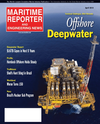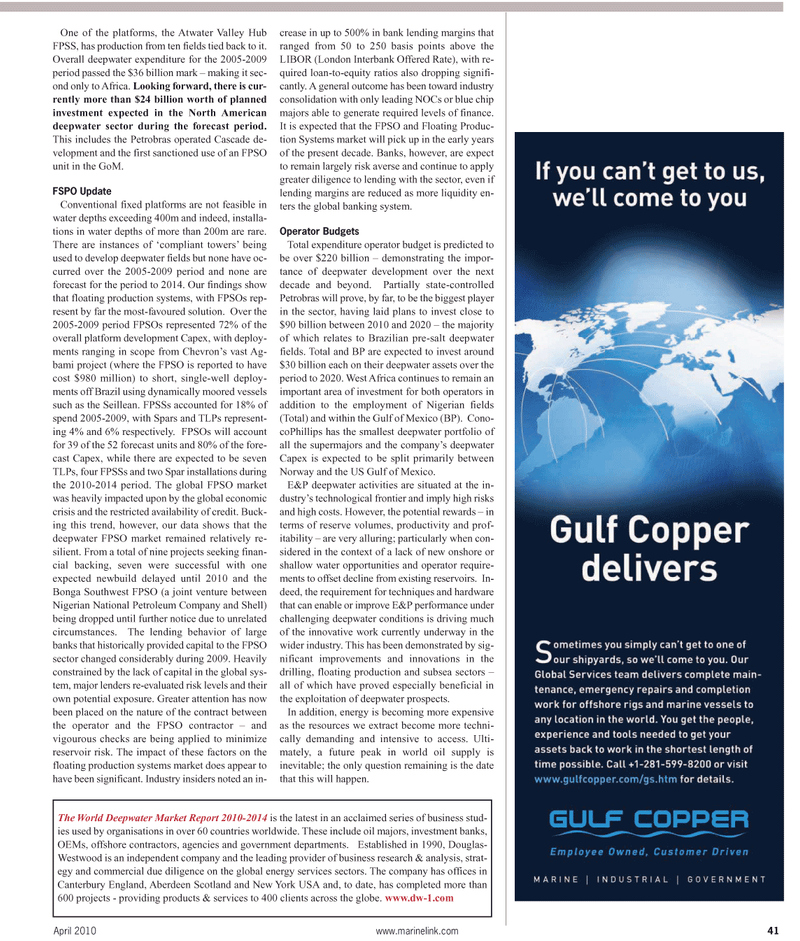
Page 41: of Maritime Reporter Magazine (April 2, 2010)
Read this page in Pdf, Flash or Html5 edition of April 2, 2010 Maritime Reporter Magazine
April 2010 www.marinelink.com 41
One of the platforms, the Atwater Valley Hub
FPSS, has production from ten fields tied back to it.
Overall deepwater expenditure for the 2005-2009 period passed the $36 billion mark – making it sec- ond only to Africa. Looking forward, there is cur- rently more than $24 billion worth of planned investment expected in the North American deepwater sector during the forecast period.
This includes the Petrobras operated Cascade de- velopment and the first sanctioned use of an FPSO unit in the GoM.
FSPO Update
Conventional fixed platforms are not feasible in water depths exceeding 400m and indeed, installa- tions in water depths of more than 200m are rare.
There are instances of ‘compliant towers’ being used to develop deepwater fields but none have oc- curred over the 2005-2009 period and none are forecast for the period to 2014. Our findings show that floating production systems, with FPSOs rep- resent by far the most-favoured solution. Over the 2005-2009 period FPSOs represented 72% of the overall platform development Capex, with deploy- ments ranging in scope from Chevron’s vast Ag- bami project (where the FPSO is reported to have cost $980 million) to short, single-well deploy- ments off Brazil using dynamically moored vessels such as the Seillean. FPSSs accounted for 18% of spend 2005-2009, with Spars and TLPs represent- ing 4% and 6% respectively. FPSOs will account for 39 of the 52 forecast units and 80% of the fore- cast Capex, while there are expected to be seven
TLPs, four FPSSs and two Spar installations during the 2010-2014 period. The global FPSO market was heavily impacted upon by the global economic crisis and the restricted availability of credit. Buck- ing this trend, however, our data shows that the deepwater FPSO market remained relatively re- silient. From a total of nine projects seeking finan- cial backing, seven were successful with one expected newbuild delayed until 2010 and the
Bonga Southwest FPSO (a joint venture between
Nigerian National Petroleum Company and Shell) being dropped until further notice due to unrelated circumstances. The lending behavior of large banks that historically provided capital to the FPSO sector changed considerably during 2009. Heavily constrained by the lack of capital in the global sys- tem, major lenders re-evaluated risk levels and their own potential exposure. Greater attention has now been placed on the nature of the contract between the operator and the FPSO contractor – and vigourous checks are being applied to minimize reservoir risk. The impact of these factors on the floating production systems market does appear to have been significant. Industry insiders noted an in- crease in up to 500% in bank lending margins that ranged from 50 to 250 basis points above the
LIBOR (London Interbank Offered Rate), with re- quired loan-to-equity ratios also dropping signifi- cantly. A general outcome has been toward industry consolidation with only leading NOCs or blue chip majors able to generate required levels of finance.
It is expected that the FPSO and Floating Produc- tion Systems market will pick up in the early years of the present decade. Banks, however, are expect to remain largely risk averse and continue to apply greater diligence to lending with the sector, even if lending margins are reduced as more liquidity en- ters the global banking system.
Operator Budgets
Total expenditure operator budget is predicted to be over $220 billion – demonstrating the impor- tance of deepwater development over the next decade and beyond. Partially state-controlled
Petrobras will prove, by far, to be the biggest player in the sector, having laid plans to invest close to $90 billion between 2010 and 2020 – the majority of which relates to Brazilian pre-salt deepwater fields. Total and BP are expected to invest around $30 billion each on their deepwater assets over the period to 2020. West Africa continues to remain an important area of investment for both operators in addition to the employment of Nigerian fields (Total) and within the Gulf of Mexico (BP). Cono- coPhillips has the smallest deepwater portfolio of all the supermajors and the company’s deepwater
Capex is expected to be split primarily between
Norway and the US Gulf of Mexico.
E&P deepwater activities are situated at the in- dustry’s technological frontier and imply high risks and high costs. However, the potential rewards – in terms of reserve volumes, productivity and prof- itability – are very alluring; particularly when con- sidered in the context of a lack of new onshore or shallow water opportunities and operator require- ments to offset decline from existing reservoirs. In- deed, the requirement for techniques and hardware that can enable or improve E&P performance under challenging deepwater conditions is driving much of the innovative work currently underway in the wider industry. This has been demonstrated by sig- nificant improvements and innovations in the drilling, floating production and subsea sectors – all of which have proved especially beneficial in the exploitation of deepwater prospects.
In addition, energy is becoming more expensive as the resources we extract become more techni- cally demanding and intensive to access. Ulti- mately, a future peak in world oil supply is inevitable; the only question remaining is the date that this will happen.
The World Deepwater Market Report 2010-2014 is the latest in an acclaimed series of business stud- ies used by organisations in over 60 countries worldwide. These include oil majors, investment banks,
OEMs, offshore contractors, agencies and government departments. Established in 1990, Douglas-
Westwood is an independent company and the leading provider of business research & analysis, strat- egy and commercial due diligence on the global energy services sectors. The company has offices in
Canterbury England, Aberdeen Scotland and New York USA and, to date, has completed more than 600 projects - providing products & services to 400 clients across the globe. www.dw-1.com

 40
40

 42
42
